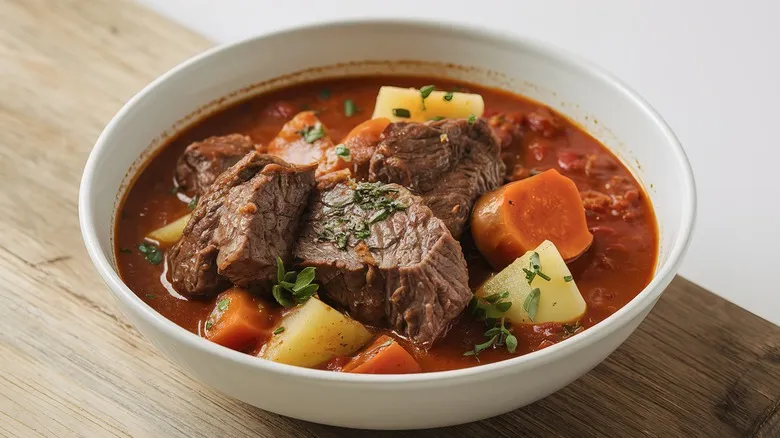Using the wrong tools

While beef stew is quite straightforward and doesn't demand extensive culinary skills, selecting the right cookware is crucial for achieving optimal results. A cast iron Dutch oven is an excellent choice for beef stew, as it accommodates a generous amount of ingredients and distributes heat evenly across everything from broth to meat to vegetables. Additionally, cast iron is perfect for browning the meat before adding the other components, transforming this dish into a convenient one-pot meal that minimizes cleanup.
"I've experimented with everything... from a slow cooker to an instant pot... to a regular stock pot," shared Debi Morgan from Quiche My Grits. "However, nothing retains heat and maintains a consistent temperature like an enameled Dutch oven. It genuinely impacts the tenderness of the meat and consistently yields a delicious beef stew." As a chef specializing in Southern cuisine, Morgan certainly understands the essence of comfort food.
The ideal size of a Dutch oven depends on the quantity of stew you're preparing, so choose one that can accommodate all your ingredients, ample broth, and still allow room for stirring. The last thing you want is to overfill your pot, making it difficult to mix everything properly—an essential step for even cooking. If you're planning to make a large batch to freeze for later, consider using an oversized stock pot or a large Dutch oven.
Adding ingredients too soon

One of the most common errors people make when preparing beef stew, particularly when they're pressed for time, is to toss all the ingredients into the pot simultaneously and hope for the best. While it may seem inconsequential since everything cooks together, hurrying the ingredients into the stew prevents each one from cooking for the appropriate duration. This can lead to a disappointing outcome for this slow-cooked dish, which requires time to develop the best flavor and texture.
Debi Morgan learned the secret to achieving tender beef from her mother and now incorporates it into her own stew recipes. "If you rush and add other vegetables to the pot too early, it can make the meat tough," she explained. "I simmer the beef in beef broth (or dark beer, depending on the recipe) for at least one hour per pound until it becomes melt-in-your-mouth tender. After that, I add carrots and potatoes and cook them until they're tender, which usually takes about an hour, depending on the amount."
Starting the beef cooking first is crucial for both flavor and texture. If you overload the pot with vegetables too soon, it can be challenging to achieve a nice browning on the meat. Fortunately, allowing the meat to brown and turning it evenly for just a few minutes over high heat is sufficient to create the delicious crust you desire.
Choosing the wrong cut
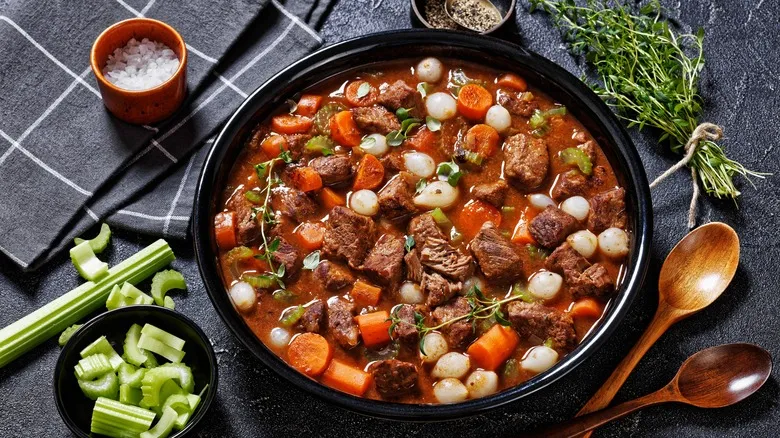
Although beef is a key ingredient in beef stew, many people often select the wrong cut or are unaware of which cut they are using. When preparing this dish, aim for a budget-friendly cut that contains some fat to enhance the flavor. You can opt for pre-cut stew meat, which is convenient and ready to use, or purchase a larger roast and cut it yourself. Chuck roast and bottom round are excellent choices that are both economical and easy to incorporate into stew recipes. They have sufficient fat to contribute flavor while remaining lean enough to prevent the stew from becoming overly greasy. These cuts can also be diced into bite-sized pieces and browned before adding broth and vegetables. Chuck steak and chuck roast can be used interchangeably, as they come from the same section of the cow, though you'll need several steaks to yield enough meat.
Short ribs are another great option, providing added richness due to their bone-in nature. Dagan Lynn, executive chef at the National Cattlemen's Beef Association, suggests using short ribs for slow cooker stews. "Short ribs will yield tender, fall-off-the-bone meat that is ideal for stews," he explains. "Additionally, this bone-in cut contributes extra flavor from the marrow."
Not cutting it into cubes
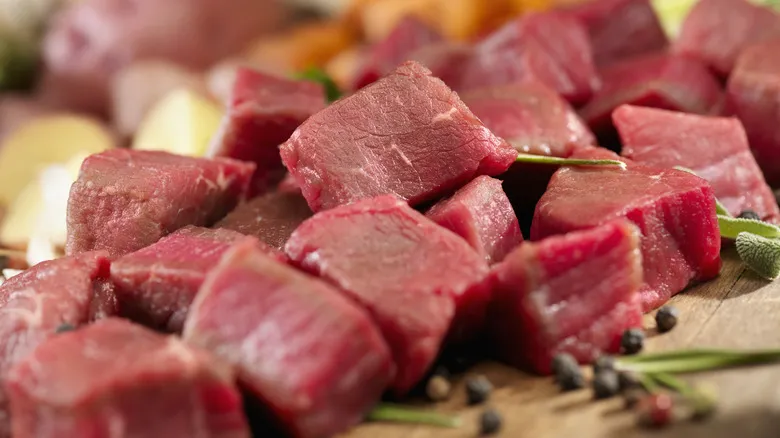
A good stew is hearty yet easy to enjoy with a spoon. While larger chunks of meat are typically preferred for steak, when it comes to stew, you may need to trim or cut a larger roast to achieve the best results. Beef stew is most effective with bite-sized pieces of meat, as they not only cook more quickly but also blend better with the other ingredients. Chef Dagan Lynn suggests cutting the meat into 1-inch cubes to ensure that each bite includes a taste of beef. After all, what’s a beef stew without a piece of beef in every mouthful? However, it's advisable not to cut the stew meat any smaller, as you want to preserve enough texture to maintain the dish's heartiness.
When preparing your meat, ensure that the pieces are approximately the same size. Uniform pieces guarantee even cooking, preventing any undercooked or overcooked bites in the same batch. Smaller pieces provide more surface area for browning, which enhances the dish's flavor. Additionally, chop your vegetables to match the size of your stew meat. Ideally, they should be similar in size, although more delicate vegetables may start to break down if they are stewed for too long.
Not browning your meat
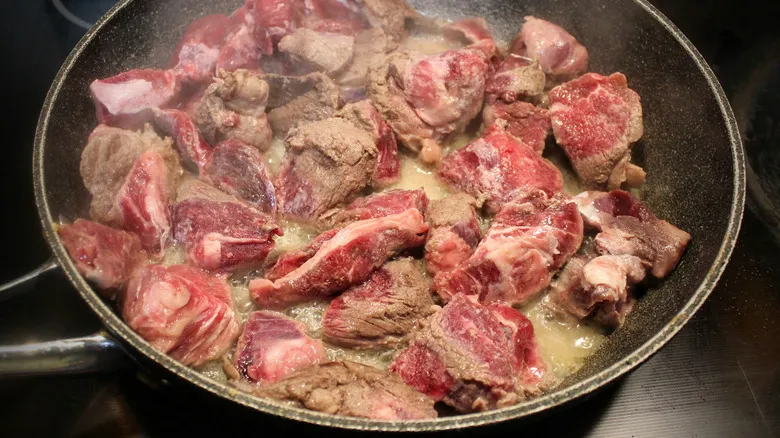
One of the most significant flavor errors people often make is adding liquid and starting to stew immediately. Before incorporating any other ingredients into your pot, take the time to brown the beef on the outside. This step creates a crispy texture, especially noticeable on larger cuts of meat, and infuses a wealth of savory flavor. To enhance this taste further, season the exterior with just salt and pepper. Chef Dagan Lynn suggests browning the meat over medium-high heat and using oil with a high smoke point to avoid burning as it heats up.
Browning the meat contributes both flavor and texture due to the Maillard reaction. "This step is crucial for locking in more complex flavors, and the caramelization improves the appealing color of the stew," explains Karen Tedesco from Familystyle Food. While the Maillard reaction and caramelization are not identical chemical processes, both play a vital role in enhancing the flavors of ingredients when subjected to heat. The proteins in the meat react to the high temperatures, resulting in a browning effect that adds savory flavor and that deeply rich aroma that makes our mouths water.
Using too little liquid

Ensure that all your ingredients are fully submerged in liquid, particularly when preparing beef stew in a slow cooker. You can enhance the flavor by incorporating broth, beer, or other components. An unexpected yet delightful addition is V8, which brings extra flavor and acidity to the dish. Italian dressing is another excellent choice, as it already contains oil, vinegar, and spices. While you'll need a robust base, usually from broth, to complement its strong flavors, it can be a cost-effective way to boost taste.
The necessary amount of liquid varies based on all the ingredients in your stew, not just the beef. "Consider the vegetables and liquids (beef broth, wine, beer, water, etc.)," advises Dagan Lynn. "Ensure that all your ingredients are immersed in the liquid."
Debi Morgan suggests adding just one onion along with the beef broth while simmering the meat before adding more ingredients to the stew. This method helps the meat become extra tender, but it may require you to add more liquid later in the cooking process. Don’t hesitate to make adjustments as needed to keep the liquid level above the beef, vegetables, spices, and other additions.
Lifting the lid

Chef Dagan Lynn emphasizes that one of the most common errors people make is failing to "stew the stew." To achieve the most tender and flavorful results, it's essential to allow it to cook undisturbed. This involves bringing it to a simmer and letting it be. Frequently lifting the lid to check on it disrupts the cooking process. Not only does this lower the temperature of the stew, but it also releases steam, which is crucial for ensuring that all the vegetables become tender. The best approach is to simply cover the stew and step away for a couple of hours.
To determine if the beef is cooked, you can use a fork to test it. This same method applies to the vegetables in the stew. Once you can easily pierce them with a fork, the dish is ready to be served in a bowl and enjoyed. Unlike pot roast, which cooks in the oven, beef stew is somewhat easier to monitor since it simmers on the stovetop. Using a stock pot with a clear lid allows you to check on it without having to lift the lid.
Buying unknown stew meat

It may seem clear that the packages labeled as stew meat would be the best option at the grocery store. However, these packages often contain leftover cuts from various orders, all chopped into uniform pieces to enhance their appeal and minimize waste for the butcher.
You might assume that purchasing pre-cut stew meat would save you time, but you may find yourself with cuts that are difficult to prepare. If the package contains a mix of different cuts, each with its own cooking characteristics, some pieces may end up dry or tough while others remain tender. This can lead to a stew with inconsistent textures instead of the melt-in-your-mouth beef you desire. Trying to figure out how to cook this assorted meat can ultimately take longer and yield less satisfying results.
For optimal results, it's better to buy a larger chuck roast and cut it yourself at home. "To achieve a stew with fork-tender meat, it's advisable to purchase a 3 to 4-pound boneless beef chuck roast and trim it yourself," advises Karen Tedesco. The exception to this is when butcher counters clearly label their stew meat with the specific type of beef used, which is more common in specialty butcher shops. Some stores also offer custom cutting, allowing you to collaborate with the butcher to select the best cut and size of stew meat for your recipe.
Cutting pieces too small
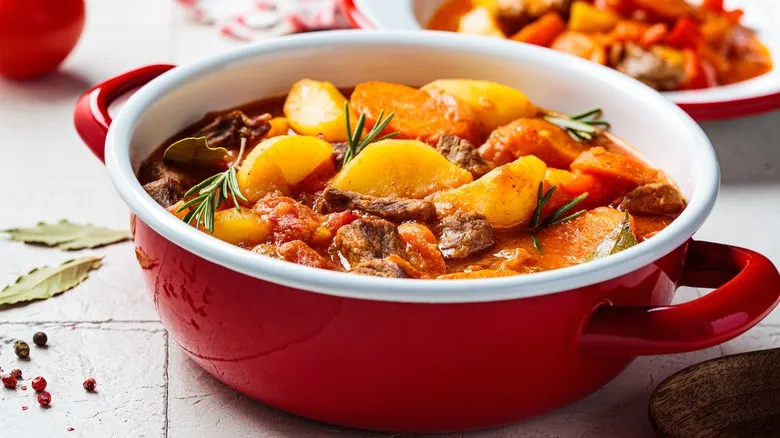
While it's essential to cut larger beef cuts into manageable pieces, be cautious not to make them too small, as this can compromise the dish's tender texture. Stew meat that is overly small may dry out, even though a longer cooking time is necessary for the flavors to blend. Karen Tedesco suggests selecting beef with good marbling and cutting it into 3-4 inch pieces for a flavorful and tender result. As the beef braises, the fat renders, enhancing the dish's flavor and ensuring the meat remains tender.
Chef Dagan Lynn prefers to cut his stew meat into 1-inch pieces when preparing to serve. He opts for smaller chunks to ensure that each spoonful contains a balanced mix of all ingredients, including both beef and vegetables.
When browning beef, larger pieces occupy more space at the bottom of the Dutch oven, while smaller pieces can fit together more snugly. You may need to use tongs to turn larger chunks to sear each side, whereas smaller pieces can be easily flipped with a spatula or spoon.
Adding vegetables too early
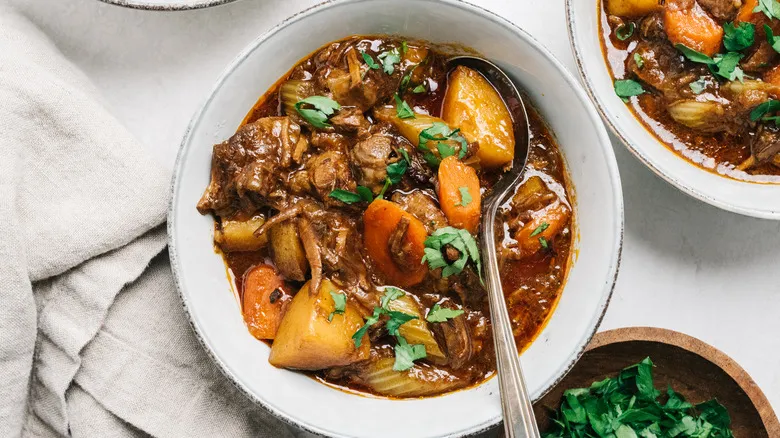
One of the most common errors people make is adding all the vegetables to the beef at the beginning. This not only hinders the beef from becoming tender but can also lead to overcooked, mushy vegetables in the stew. Instead, incorporate the vegetables gradually after browning the meat. Start with root vegetables like carrots and potatoes, then add quicker-cooking above-ground vegetables such as celery and peppers.
Jennifer Borchardt, Culinary Director for Pre Brands, suggests a two-step approach to making stew. She adds vegetables during the cooking process to enhance flavor, then removes them and introduces a fresh batch later. "The initial vegetables can be blended into a different soup base to minimize waste, while the ones added later will be perfectly cooked by the time the stew is finished," she explains. This method helps prevent the unpleasant mushiness that results from overcooking.
The only exception to this guideline is when you want to thicken the stew with a vegetable slurry. Instead of using a flour-based roux, mash some of the extra tender vegetables, like potatoes and carrots, with broth. When this mixture is reintroduced to the stew, it thickens and enriches the dish. This technique is particularly helpful if your stew resembles a vegetable beef soup and you desire a heartier consistency.
Skipping the simmering
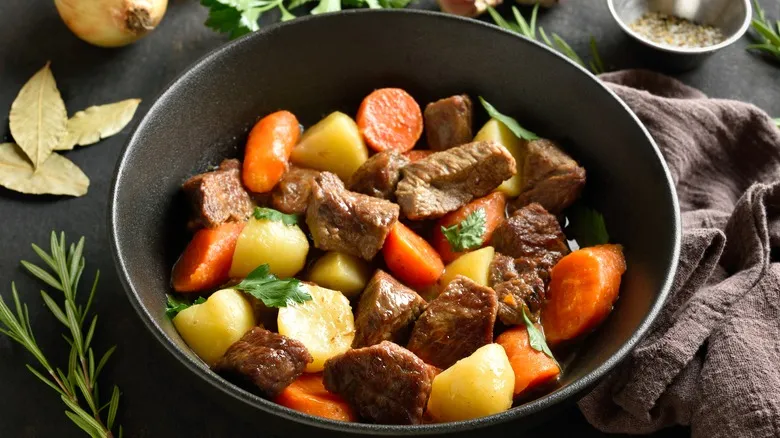
It can be tempting to serve your beef stew as soon as all the ingredients are fully cooked, but the finest recipes benefit from simmering for a few hours. This extended cooking time allows the flavors to meld and ensures the beef becomes incredibly tender. Even if the beef is cooked through, it still requires time to simmer in the stew for optimal texture. This process breaks down tough collagen in the meat, resulting in wonderfully tender bites.
Incorporate seasonings and spices, including fresh herbs, early in the cooking process to enhance the flavor of all the ingredients as they simmer. While the stew is cooking, try to resist the urge to check on it too frequently. Simply lower the heat and let it work its magic. It’s a good idea to taste the stew occasionally, but limit yourself to just a spoonful and quickly replace the lid.
Debi Morgan ensures that the temperature remains steady as the beef simmers for at least an hour before adding vegetables to the pot. The meat needs the longest cooking time, but you can still add salt, pepper, and herbs at this stage to enhance the flavor. Additionally, it’s crucial to ensure there is enough liquid to fully cover the beef while it simmers.
Recommended
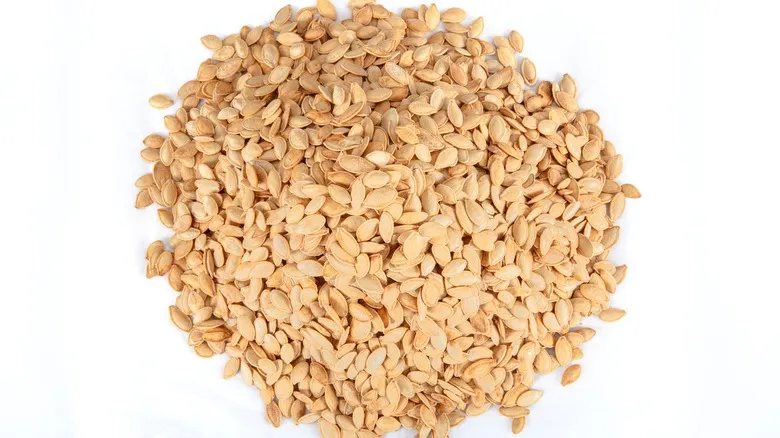
The Crucial Tip To Follow For The Crispiest Roasted Pumpkin Seeds

The Traditional Thanksgiving Side That Has No Place On Ina Garten's Table

The Grilled Cheese Addition Gordon Ramsay Uses For Deep, Rich Flavor
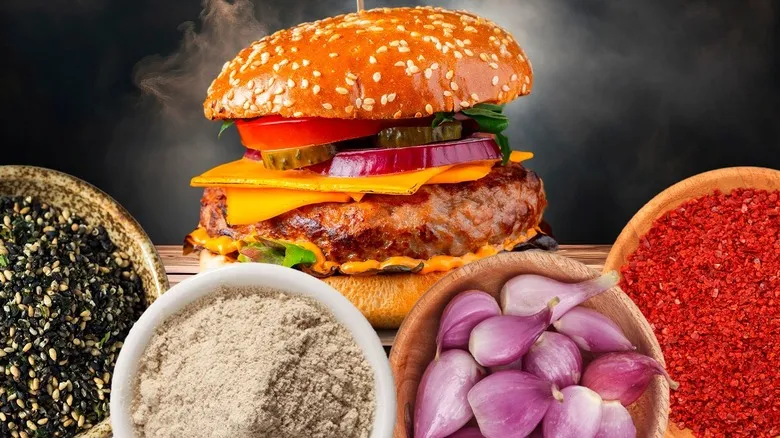
13 Unexpected Seasonings For Restaurant-Quality Burgers
Next up

